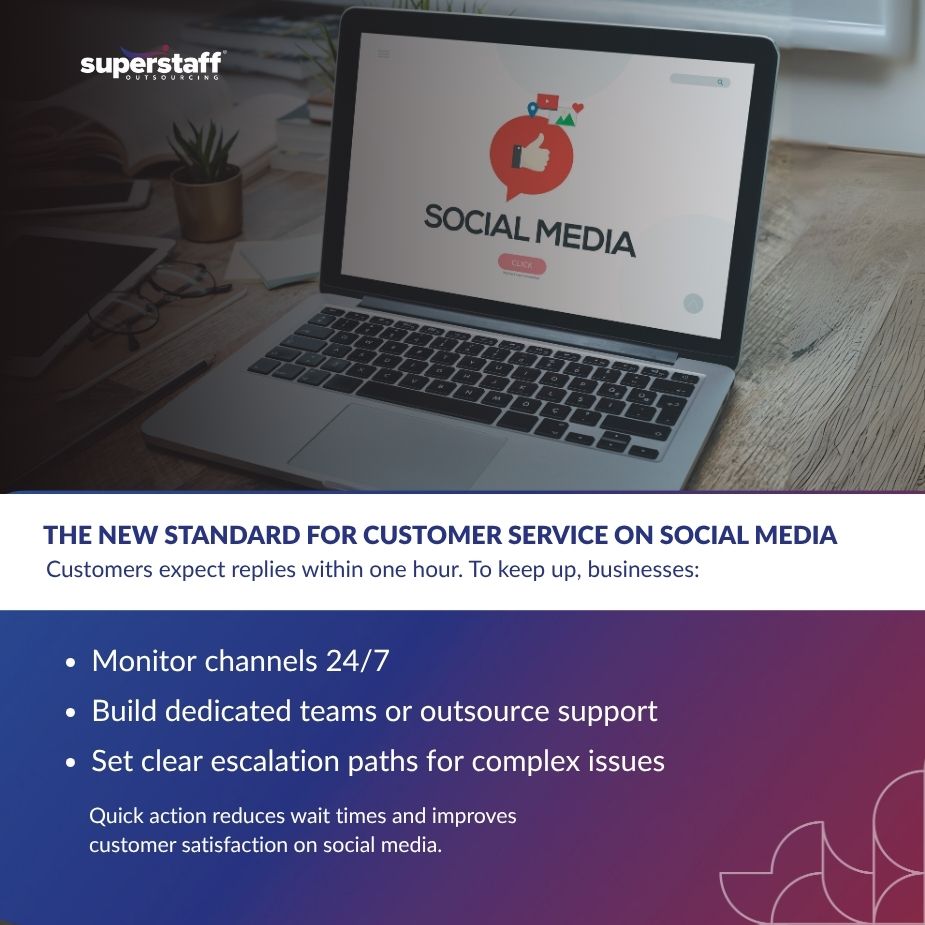
Customers want more than just answers. They want to be heard, and they want it fast. When someone tags a brand or sends a direct message online, they expect a quick reply—often within minutes. This shift has changed how businesses handle support.
Customer service on social media is now a regular part of doing business. Companies no longer rely only on phone calls or emails. Platforms like Facebook, X (formerly Twitter), Instagram, and LinkedIn have become important channels for support.
This article explains how customer service on social media is changing the way businesses interact with their customers. We’ll also share tips and examples to help companies meet growing expectations and build stronger relationships.
Customer Service in the Public Eye
Customer service on social media is different from traditional channels because it happens in public. When customers post questions or complaints, others can see how the company responds.
- If the reply is quick and helpful, people trust the brand more. Research indicates that 61% of executives believe enhancing customer service is a high priority to encourage brand loyalty. Timely and effective responses on social media can foster trust and strengthen customer relationships.
- If there’s no response or if the reply is rude, it damages the brand’s image.
- One bad comment can spread quickly and affect many future customers.
For businesses, this means every reply matters. Companies need to treat each message like a chance to build trust.
Public feedback is no longer just for review sites. Now, it happens in real time on social platforms.
Fast Response Times: A New Standard for Customer Service on Social Media

People expect fast responses on social media—often within one hour. Businesses are adjusting their operations to keep up.
Here’s how:
1. 24/7 Monitoring
Customers can send messages at any time. Businesses need tools or teams that monitor messages around the clock.
2. Dedicated Teams or Outsourcing
To keep up with growing demand, many companies build specialized support teams focused on social media. Others choose to outsource to partners who provide fast customer service on social media. Both approaches help ensure timely and effective responses.
3. Clear Escalation Paths
Some issues are too complex to solve with one reply. Teams must know how to forward these cases quickly to the right department.
Companies that invest in these changes can reduce wait times and increase satisfaction.
Listening and Learning: Customer Feedback in Real Time
Customer service on social media also includes listening, not just replying.
Benefits of social media customer service:
- Find issues before they grow into bigger problems
- Discover what customers like or dislike
- Get suggestions directly from users
Social listening tools help businesses track trends, complaints, and compliments across platforms. This information helps improve services, products, and communication.
By listening actively, companies can fix problems faster and show that they care.
Moving From Reaction to Prevention
Another big shift in customer service on social media is moving from reactive to proactive support.
Instead of waiting for complaints, companies now reach out first.
Here are some ways businesses stay ahead:
- Post Updates Early
Letting customers know about delays, outages, or changes prevents confusion. - Share Useful Tips
Answer common questions before they’re even asked by posting how-to guides or videos. - Follow Up With Customers
A short message checking in after a solution shows that the company values the relationship.
These simple steps help reduce frustration and increase trust.
Training Teams for Customer Service on Social Media
Helping customers through social platforms needs a different set of skills than handling phone or email support.
Here’s how businesses train their teams:
1. Clear and Friendly Tone
Messages should be polite but not robotic. Support teams need to sound like real people while staying professional.
2. Platform Know-How
Each platform is different:
- X needs short replies.
- Facebook allows longer, more detailed messages.
- Instagram relies more on visuals.
3. Handling Negative Comments
Bad reviews or angry messages are public. Support teams must stay calm and respectful, even in tough situations.
Good training helps agents stay consistent and positive. This leads to better customer outcomes and protects the brand image.
Building a Strong Customer Service Social Media Strategy
A strong customer service social media strategy is not just about replies. It also includes planning, tracking, and improving over time.
Key parts of a solid strategy:
- Setting reply time targets and tracking results
- Creating a library of common responses to save time
- Choosing the right platforms based on where your audience is active
- Reviewing performance monthly to find areas for improvement
Following the 12 best practices in social media customer service can help build a strategy that’s both effective and sustainable. These include consistency, empathy, speed, transparency, and learning from feedback.
How to Use Social Media for Customer Service
If you’re just starting, here’s a simple guide on how to use social media for customer service:
- Pick your platforms wisely. Focus on where your customers are most active.
- Set clear goals. Define what good service looks like on each channel.
- Train your team. Make sure agents understand both the tools and tone.
- Use tools. Scheduling tools and chatbots can help manage volume.
- Track and improve. Review metrics like response time, resolution rate, and customer feedback.
Why It Matters: The Benefits of Social Media Customer Service
Using social media for customer support brings many benefits:
- Faster service: Real-time replies keep customers happy.
- Public trust: Transparent communication builds a strong brand reputation.
- Direct feedback: Easy access to customer opinions helps improve services.
- Stronger relationships: Personalized support and follow-ups show that customers matter.
These benefits help businesses grow and stay competitive.
Make Customer Service on Social Media Work for You
Customer service on social media is no longer optional. Customers expect quick replies, respectful communication, and visible solutions. Companies that meet these expectations build stronger connections and gain trust.
From faster response times to proactive support, social platforms offer new ways to serve customers better. But success requires the right tools, training, and strategy.
If your team needs support, SuperStaff offers expert solutions to help you deliver responsive and reliable customer service on social media. Stay connected, stay consistent, and let your brand shine where your customers already are.






